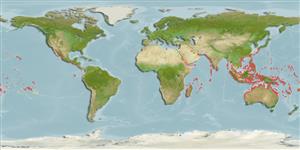Common names from other countries
>
Centrarchiformes (Basses) >
Kuhliidae (Aholeholes)
Etymology: Kuhlia: Because of Heindrich Kuhl, 1797-1821; researcher also with lizards (Gekkonidae).
More on author: Forster.
Environment: milieu / climate zone / depth range / distribution range
Ecologia
marinhas; estuarina associadas(os) a recifes; intervalo de profundidade 3 - 18 m (Ref. 5227). Tropical; 32°N - 32°S
Indo-Pacific and Eastern Pacific: Red Sea and East Africa to the eastern Pacific, north to southern Japan, south to New South Wales and Lord Howe Island. Absent from Easter Island, Pitcairn, Marquesas, Hawaiian Islands and Johnston Island.
Tamanho / Peso / Idade
Maturity: Lm ? range ? - ? cm
Max length : 40.0 cm SL macho/indeterminado; (Ref. 4967); common length : 20.0 cm TL macho/indeterminado; (Ref. 30573)
Espinhos dorsais (total) : 10; Raios dorsais moles (total) : 10 - 11; Espinhos anais: 3; Raios anais moles: 10 - 12. Preorbital serrae 11-14; body depth 2.75-3.05 in SL; caudal concavity 1.85-2.6 in head length; Silvery, the front of snout and chin blackish; caudal fin white with a median dark stripe and two broad oblique black bands across each lobe, the lobe tips white; a dusky band in outer part of soft portion of dorsal fin except for white tip of high anterior part. Juveniles (2.0-3.0 cm SL) have the median and outer black bands in the caudal fin lobes, but the middle band is represented only by a black spot basally in the outer part of each lobe (Ref. 41640).
Tightly packed schools occur along the reef margin of rocky shorelines, from just below the breaking surf to a depth of a few meters. Young commonly in tide pools (Ref. 41640). Sometimes found in estuaries but reported to never enter freshwater environments (Ref. 41640). Feeds on free-swimming crustaceans and small fishes at night (Ref. 5213). Utilized fresh or dried salted (Ref. 7271).
Life cycle and mating behavior
Maturities | Reprodução | Spawnings | Egg(s) | Fecundities | Larvas
Randall, J.E. and H.A. Randall, 2001. Review of the fishes of the genus Kuhlia (Perciformes: Kuhliidae) of the Central Pacific. Pac. Sci. 55(3):227-256. (Ref. 41640)
Categoria na Lista Vermelha da IUCN (Ref. 130435)
CITES (Ref. 128078)
Not Evaluated
Ameaça para o homem
Harmless
Utilização humana
Pescarias: pouco comercial; Aquário: Aquários públicos; isco: usually
Ferramentas
Relatórios especiais
Descarregue XML
Fontes da internet
Estimates based on models
Preferred temperature (Ref.
115969): 24.5 - 29.3, mean 28.3 (based on 3387 cells).
Phylogenetic diversity index (Ref.
82804): PD
50 = 0.5002 [Uniqueness, from 0.5 = low to 2.0 = high].
Bayesian length-weight: a=0.01413 (0.00591 - 0.03375), b=3.06 (2.86 - 3.26), in cm Total Length, based on LWR estimates for this (Sub)family-body shape (Ref.
93245).
Nível Trófico (Ref.
69278): 3.8 ±0.60 se; based on food items.
Resiliência (Ref.
120179): Baixo, tempo mínimo de duplicação da população 4,5 - 14 anos (Preliminary K or Fecundity.).
Fishing Vulnerability (Ref.
59153): Moderate vulnerability (39 of 100).
